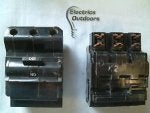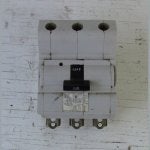Hi all, I am working on a price for a commercial office area, the old 3phase panel is full and I need a new subpanel for the supply of 2000sqft of office space. There is no heavy loads, its basically:5 circuits for receptacles, 1 circuit for emergency system, 1 Circuit for lighting.
The main panel is 225A old commander, (transformer is delta wye) I am trying to figure out if I can put a 100A single phase Subpanel on the new area (about 60ft from main electrical room)
Would that be in compliance with code, I cant find where it denies it, I am working on giving them a price on the 3 phase subpanel as well, but want to know if its legal doing the 1phase subpanel.
Also does the subpanel need to have a main disconnect? For what I understand if its in the same building it doesn't need and MLO panel can be installed, if you guys can aid me with the code will help, cant find it 😓.
Lastly i did the calculation from table 14, 2036ft²=189m² x50W/m=9450W/208V=45.43A....so instead of going with a 100A subpanel I could go with a 60A???
Thank you guys, sooner the better because they want the estimate ASAP.
The main panel is 225A old commander, (transformer is delta wye) I am trying to figure out if I can put a 100A single phase Subpanel on the new area (about 60ft from main electrical room)
Would that be in compliance with code, I cant find where it denies it, I am working on giving them a price on the 3 phase subpanel as well, but want to know if its legal doing the 1phase subpanel.
Also does the subpanel need to have a main disconnect? For what I understand if its in the same building it doesn't need and MLO panel can be installed, if you guys can aid me with the code will help, cant find it 😓.
Lastly i did the calculation from table 14, 2036ft²=189m² x50W/m=9450W/208V=45.43A....so instead of going with a 100A subpanel I could go with a 60A???
Thank you guys, sooner the better because they want the estimate ASAP.








